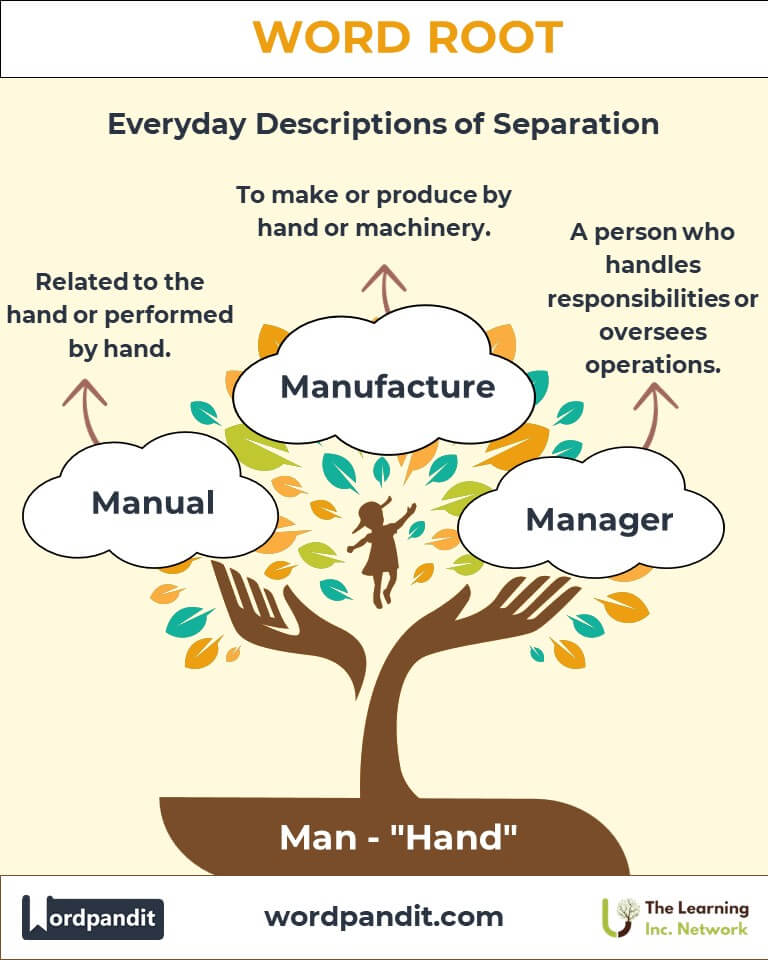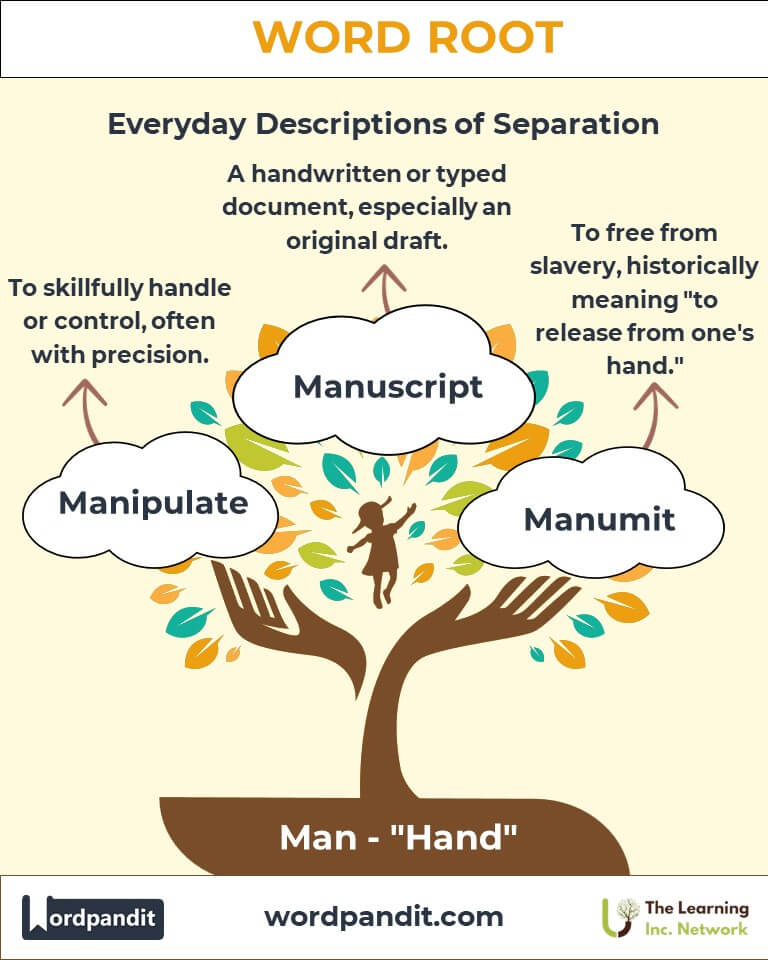Discover the essence of the word root "man," originating from the Latin word manus, meaning "hand." From terms like "manual" to "manufacture," this root reflects humanity’s connection to skill, work, and creation.

Table of Contents
- Introduction: The Mastery of "Man"
- Etymology and Historical Journey
- Mnemonic: Unlocking the Power of "Man"
- Common "Man"-Related Terms
- "Man" Through Time
- "Man" in Specialized Fields
- Illustrative Story: "Man" in Action
- Cultural Significance of the "Man" Root
- The "Man" Family Tree
- FAQs about the "Man" Word Root
- Test Your Knowledge: "Man" Mastery Quiz
- Conclusion: The Living Legacy of "Man"
Introduction: The Mastery of "Man"
Think of the word "manual" or the phrase "handmade." Both evoke images of skilled hands shaping the world. The root "man" (pronounced man), derived from the Latin manus (hand), symbolizes human ingenuity and dexterity. Whether in traditional crafts or modern manufacturing, this root encapsulates the connection between effort and creation.

Etymology and Historical Journey
The root "man" originates from Latin, where manus meant "hand." Over time, this root merged with verbs and suffixes to describe activities, objects, and ideas associated with manual work and dexterity. The Industrial Revolution, with its emphasis on manufacturing, brought a resurgence of "man"-based terms, integrating them into technical and everyday language.
Mnemonic: Unlocking the Power of "Man"
Visualize a skilled artisan molding clay with their hands, symbolizing creation through manual effort.
Mnemonic Device: "‘Man’ makes mastery—where hands create wonders."
Common "Man"-Related Terms
- Manual (man-yoo-uhl): Related to the hand or performed by hand.
- Example: The car’s manual transmission required the driver’s control.
- Manufacture (man-yoo-fak-chur): To make or produce by hand or machinery.
- Example: This factory specializes in the manufacture of luxury goods.
- Manuscript (man-yoo-skript): A handwritten or typed document, especially an original draft.
- Example: The author submitted the manuscript for publication.
- Manager (man-uh-jer): A person who handles responsibilities or oversees operations.
- Example: The manager ensured all tasks were completed on time.
- Manipulate (muh-nip-yoo-layt): To skillfully handle or control, often with precision.
- Example: The surgeon manipulated the instruments with expert precision.
"Man" Through Time
- Manumit (Ancient): To free from slavery.
- Historical Context: Derived from manus (hand) and mittere (to send), this term symbolized releasing a person from bondage.
- Manual (Medieval to Modern): Originally referring to work done by hand, the term expanded to include guides and instructions.
- Manufacture (Industrial Era): Evolving from its original meaning of "handmade," it now includes large-scale industrial production.
"Man" in Specialized Fields
- Medicine:
- Manipulation: A therapeutic technique involving skilled hand movements.
- Example: Chiropractors often perform spinal manipulation.
- Manipulation: A therapeutic technique involving skilled hand movements.
- Technology:
- Manual Input: Refers to data entered by hand into a system.
- Example: Manual input methods include typing or touchscreen gestures.
- Manual Input: Refers to data entered by hand into a system.
- Business:
- Management: The act of handling operations and resources efficiently.
- Example: Effective management is crucial for organizational success.
- Management: The act of handling operations and resources efficiently.
Illustrative Story: "Man" in Action
Meet Carlos, a craftsman whose hands create intricate wooden sculptures. His workshop is a blend of tradition and modernity, where manual skill meets innovative tools. When an apprentice struggles to carve a delicate pattern, Carlos guides them: "Feel the wood with your hands; let them lead you." His wisdom reminds us of the enduring importance of the "man" root in preserving craftsmanship.
Cultural Significance of the "Man" Root
The root "man" emphasizes humanity’s reliance on skill and effort. From ancient artisans shaping tools to modern engineers innovating with their hands, this root underscores our evolution. Cultural idioms like "in safe hands" or "hands-on approach" reflect the value placed on manual effort.

The "Man" Family Tree
- Ped (Latin: Foot):
- Pedestrian: Someone walking on foot.
- Pedal: A lever moved by the foot.
- Chir (Greek: Hand):
- Chiropractor: A specialist in manual therapy for the spine.
- Chirurgeon: An old term for a surgeon.
- Mani (Latin: Hand):
- Manifest: To show clearly, as if by hand.
- Mantle: Something that covers or is held.

FAQs About the "Man" Word Root
Q: What does the root "man" mean?
A: The root "man" comes from the Latin word manus, meaning "hand." It signifies concepts related to manual work, dexterity, and control, as seen in words like "manual" and "manipulate."
Q: How is "manual" connected to the root "man"?
A: "Manual" pertains to tasks done by hand, derived from manus. Even in modern contexts, like a "manual car," the term retains its connection to physical effort and control.
Q: Why does "manufacture" refer to machine-based production?
A: Originally, "manufacture" meant "made by hand," combining manus (hand) and facere (to make). Over time, its meaning expanded to include machine-based production, though it still implies human oversight.
Q: What is the origin of "manipulate," and how does it differ from "manage"?
A: "Manipulate" comes from manus (hand) and plere (to fill), meaning "to handle skillfully." It implies precision or control, while "manage," from manus and agere (to act), refers to overseeing tasks or people.
Q: What does "manuscript" literally mean, and how is it used today?
A: "Manuscript" combines manus (hand) and scriptus (written), meaning "written by hand." Historically, it referred to handwritten documents. Today, it denotes an original draft of a written work, regardless of format.
Test Your Knowledge: Man Mastery Quiz
1. What does the root "man" signify?
2. Which term means to produce by hand or machine?
3. What does "manipulate" imply?
4. Which term describes a handwritten document?
5. What is the origin of "manager"?
Conclusion: The Living Legacy of "Man"
The root "man" celebrates the ingenuity and dexterity inherent in human hands. From crafting objects to managing tasks, it reflects humanity’s capacity to create and innovate. As technology evolves, the essence of "man" continues to remind us of the enduring importance of skill and craftsmanship in shaping our world.












